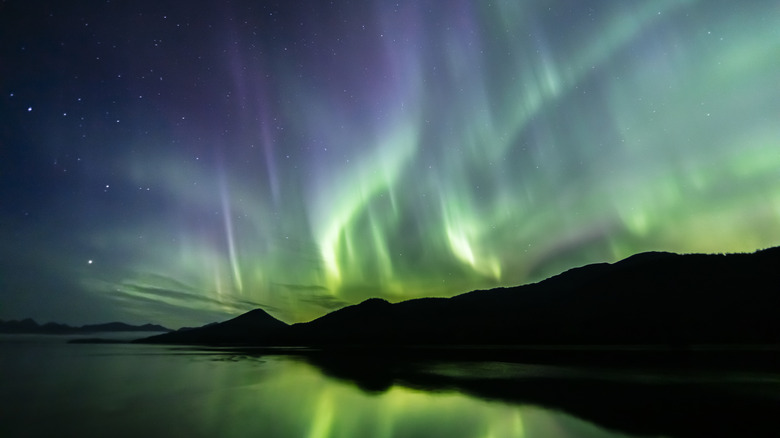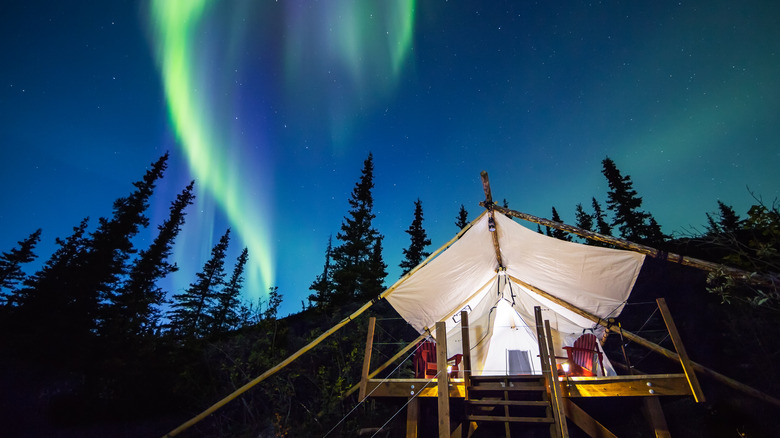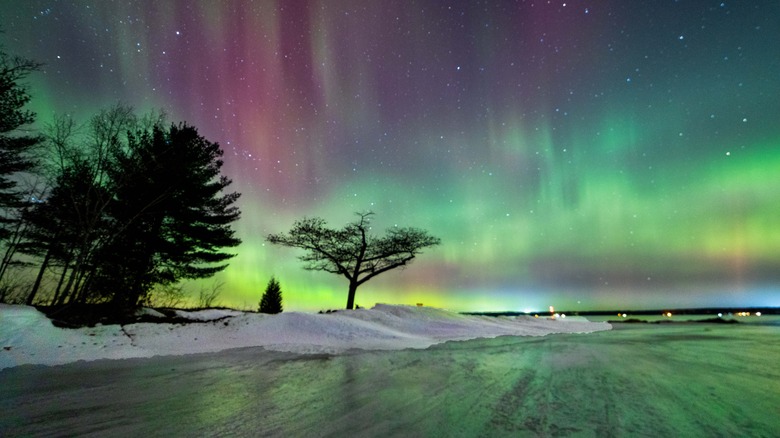The Best US State For Beautiful Views Of The Northern Lights
The Northern Lights, or aurora borealis, are nature's own light show. With waves of vibrant colors — from greens to blues, purples, and pinks — dancing across the night sky, it's a must-see spectacle that's worth the trip and the late-night trek to catch them. And while many travelers often have the misconception that a trip to the most remote corners of the globe is needed to witness this phenomenon ... the reality is far from that. So, although Europe's Nordic countries are frequently highlighted for their Northern Lights displays, there's actually no need to cross the Atlantic to catch them.
In fact, the United States has the perfect stage for this performance: Alaska. This northernmost state serves as the perfect stateside platform for watching the lights. With its vast expanses of untouched wilderness, clear, dark skies, and strategic geographical location near the pole, Alaska provides unparalleled, unobstructed views for seeing the Northern Lights. All this, along with the added benefit of its long, dark winter nights, increases the chances for travelers eager to capture these mesmerizing colors.
Chasing the aurora in Alaska
The Northern Lights are a stunning blend of nature and science. A natural phenomenon that happens when charged particles — protons and electrons — interact with the gases in Earth's atmosphere, the celestial collision creates a vibrant display of light flashes in the sky that come together and appear to glide. Because Earth's magnetic field typically pushes these particles toward the poles, auroras are more likely to happen near the North and South poles.
In order to make the most of your aurora experience in Alaska, timing and location are important. The prime window for catching a glimpse of the Northern Lights runs from August 21st to April 21st — also known as "Aurora Season" — and March is the best month to see them. Plus, the farther north you travel — like Fairbanks, for example — the more likely you'll be to get a picture-perfect show without any interference from nearby city lights. Oh, and get ready to stay up past your bedtime, too! According to experts, the best time to catch the lights is between 10 p.m. and 2 a.m.
In addition to choosing the perfect time and location, packing for cold weather and the Alaskan environment is essential. Make sure you're kitted up with warm clothes, boots, and a good hat, and anticipate sudden shifts in weather throughout the night. Also, if you're going to be driving, ensure that your vehicle is equipped for snow and ice — this includes bringing a tow rope, flares, chains, and a snow shovel.
Can't make it to Alaska?
Although Alaska is hailed as a prime destination for viewing the Northern Lights, there are several other U.S. states that offer plenty of great opportunities to see this natural spectacle in person — often at a much more accessible price point than traveling to The Land of the Midnight Sun. For one, Idaho's Panhandle National Forests are far enough away from any light pollution to make for a great viewing experience. Then, there are the clear skies near the forests and lakes of Minnesota and Michigan — both of which are perfect for seeing the light display and a relatively easy drive from most major midwestern towns and cities. Lastly, the shoreline of Malletts Bay, Vermont also provides a great vantage point for aurora enthusiasts.
And, if you want to go the extra mile and enhance your viewing experience, it's also worth looking into downloading an aurora tracker or forecaster directly onto your phone. Available as mobile apps — with My Aurora Forecast the most popular choice for both iPhone and Android users — these tools offer real-time data on solar activity, helping you pinpoint the optimal times and locations for viewing the lights.
Whether you're planning to visit Alaska or looking for a location closer to home, seeing the Northern Lights is all about planning, timing, and (in some cases) luck. Leverage the tools that are out there, don't be afraid to ask around, and remember: Patience is key. Seeing this spectacle is well worth the wait!


